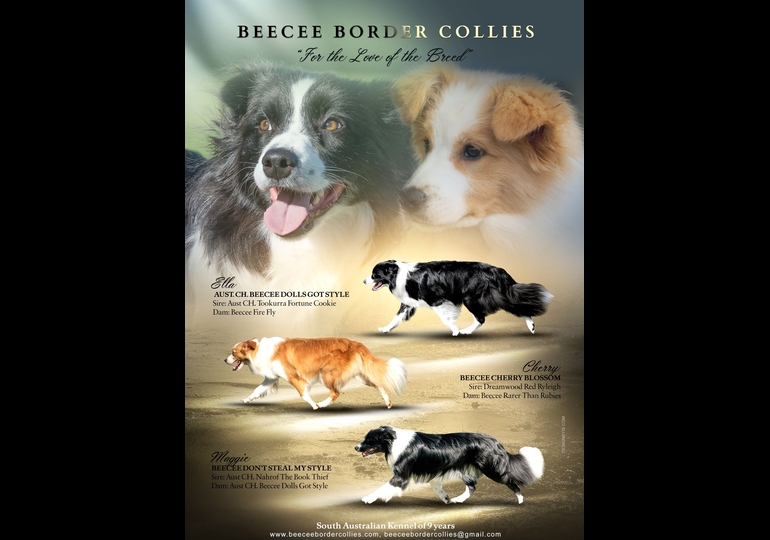Breeds
Border Collie

GROUP 5 - WORKING DOGS
History
The Border Collie originated in Scotland and can be traced back for 350 years. The name is derived from the area of its origin – the border of Scotland and England. It was introduced into northern England during the great droving days of the 18th century; it was here that one of the foundation stud dogs, ‘Old Hemp’, was whelped. It was fi rst imported into Australia in 1901 and recognised as an Australian Working Dog breed in 1953. Although it isn’t an Australian Breed, its contribution to the Australian sheep industry and unique Australian heritage has led Borders to receive a form of breed nationalisation. Australia is also regarded as the Country of Development for the Border Collie in the conformation ring.
Temperament
Borders have all the characteristics of a working dog: it is an intelligent, athletic, faithful dog with an inherent desire to please. Borders are agile, active dogs and while it is a breed capable of covering the ground at great speed and executing sudden, sharp turns, it can also display great patience and control, often characterised by the famous Border Collie ‘creep’ and the motionless stance whilst giving stock the ‘eye’.
Appearance
Borders are moderately sized with males 48-53cm at the shoulders and females 46-51cm.
Coats colours include the base pigments of black, chocolate (brown), blue (dilute black) or lilac (dilute chocolate), all with matching nose, lips, eye rims and pads. Any shade of red coat, can occur on with any of the 4 base skin pigment colours. Coat patterns of tan point, sable and merle, can also occur on any base pigment colour and in any combination with each other. Red coat will mask coat patterns including merle. All dogs have some white markings to a greater or lesser degree but white must not predominate.
Health Issues
Border Collies have an average life expectancy of 12-15 years.
They are a generally healthy breed although a number of hereditary diseases occur in the breed. Fortunately, for many diseases, DNA tests are available and reputable breeders always test their breeding stock to ensure that no puppies are affected by any of these diseases. Where only a physical test is available, for example Hip Dysplasia (HD), breeders screen their dogs to reduce the likelihood of these conditions occurring in their puppies.
When purchasing a puppy, please ensure that breeders provide evidence of the DNA test results and physical test results (for example Hip/Elbow/Eye results) for the sire and dam.
DNA Tests available for hereditary diseases affecting Border Collies are:
● Collie Eye Anomaly/ Choroidal Hypoplasia (CEA/CH)
● Trapped Neutrophil Syndrome (TNS)
● Neuronal Ceroid Lipofuscinosis 5 (NCL5)
● Raine Syndrome /Canine Dental Hypomineralisation (RS or DH)
● Imerslund-Grasbeck Syndrome (IGS) [aka Intestinal Cobalamin (Vit B12) Malabsortion (ICM)]
● Sensory Neuropathy (SN)
● Degenerative Myelopathy (DM)
● Multi Drug Resistance (MDR1)
● Goniodysgenesis predisposition (Goniodysgenesis/Glaucoma)
● Early Adult Onset Deafness (EAOD)
Physical Tests available for hereditary diseases or disorders affecting Border Collies are:
● Hip and Elbow Dysplasia (HD and ED) – X-rays and Scoring by ANKC approved panel (CHEDS)
● Eye Diseases - Glaucoma, Progressive Retinal Atrophy (PRA), Primary Lens Luxation (PLL) - examinations/screening by Canine Opthalmologist (ANKC ACES)
Diseases for which no test is available include Discoid Lupus (Collie Nose), Epilepsy and Border Collie Collapse (BCC). Buyers should ask the breeder whether there is a history of these diseases in the parents. Parents affected by these conditions should not be bred from to reduce the risk of producing an affected puppy.
Before purchasing a Border Collie puppy, please take the time to visit the website of the National Border Collie Council where you will find lots of helpful information regarding Border Collies including full details of the various health testing that is undertaken by responsible breeders. Please visit: https://www.nationalbordercolliecouncilau.org/breed-health.html
Suitability
Most of today’s Border Collies don’t work so their energy and intelligence is channeled into activities including Obedience, Agility, Tracking and showing. Being very intelligent, Border Collies are easily trained; however, this breed also needs a structured and disciplined environment. Catering for mental energy is just as important as physical exercise. Border Collies need an active owner who is willing to involve the dog in all family activities in addition to some socialisation and formal training.
Maintenance and Grooming
Border Collies have a moderately long, medium-textured topcoat and a short dense undercoat, which provides good insulation and weather protection. Generally, the coat is not subject to matting and tangling although this can occur during a coat drop if the dead hair is not removed.
Information from The Border Collie Club of NSW
Image: Border Pix N Art Photography
In Conclusion
Now you know a little about the Border Collie you may have think that this is the dog for you. Before you make a decision, please make contact with the breed club or your State controlling body for purebred dogs. They will be able to give you information about available puppies and also suggest dog shows where you can see the breed and speak to breeders. In this way you will gain a better perspective of the Border Collie and its needs and whether this breed would suit your lifestyle.
Breeders




